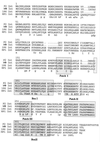The transcriptional switch of bacteriophage WPhi, a P2-related but heteroimmune coliphage
- PMID: 10559293
- PMCID: PMC113030
- DOI: 10.1128/JVI.73.12.9816-9826.1999
The transcriptional switch of bacteriophage WPhi, a P2-related but heteroimmune coliphage
Abstract
Phage WPhi is a member of the nonlambdoid P2 family of temperate phages. The DNA sequence of the whole early-control region and the int and attP region of phage WPhi has been determined. The phage integration site was located at 88.6 min of the Escherichia coli K-12 map, where a 47-nucleotide sequence was found to be identical in the host and phage genomes. The WPhi Int protein belongs to the Int family of site-specific recombinases, and it seems to have the same arm binding recognition sequence as P2 Int, but the core sequence differs. The transcriptional switch contains two face-to-face promoters, Pe and Pc, and two repressors, C and Cox, controlling Pe and Pc, respectively. The early Pe promoter was found to be much stronger than the Pc promoter. Furthermore, the Pe transcript was shown to interfere with Pc transcription. By site-directed mutagenesis, the binding site of the immunity repressor was located to two direct repeats spanning the Pe promoter. A point mutation in one or the other repeat does not affect repression by C, but when it is included in both, C has no effect on the Pe promoter. The Cox repressor efficiently blocks expression from the Pc promoter, but its DNA recognition sequence was not evident. Most members of the P2 family of phages are able to function as helpers for satellite phage P4, which lacks genes encoding structural proteins and packaging and lysis functions. In this work it is shown that P4 E, known to function as an antirepressor by binding to P2 C, also turns the transcriptional switch of WPhi from the lysogenic to the lytic mode. However, in contrast to P2 Cox, WPhi Cox is unable to activate the P4 Pll promoter.
Figures






Similar articles
-
A comparison of the DNA binding and bending capacities and the oligomeric states of the immunity repressors of heteroimmune coliphages P2 and WPhi.Nucleic Acids Res. 2007;35(10):3167-80. doi: 10.1093/nar/gkm171. Epub 2007 May 7. Nucleic Acids Res. 2007. PMID: 17485481 Free PMC article.
-
A comparative analysis of the bifunctional Cox proteins of two heteroimmune P2-like phages with different host integration sites.Virology. 2009 Mar 15;385(2):303-12. doi: 10.1016/j.virol.2008.12.002. Epub 2009 Jan 15. Virology. 2009. PMID: 19150106
-
The Cox protein is a modulator of directionality in bacteriophage P2 site-specific recombination.J Bacteriol. 1993 Dec;175(24):7848-55. doi: 10.1128/jb.175.24.7848-7855.1993. J Bacteriol. 1993. PMID: 8253674 Free PMC article.
-
Interactions between satellite bacteriophage P4 and its helpers.Annu Rev Genet. 1990;24:465-90. doi: 10.1146/annurev.ge.24.120190.002341. Annu Rev Genet. 1990. PMID: 2088176 Review.
-
Mechanisms of genome propagation and helper exploitation by satellite phage P4.Microbiol Rev. 1993 Sep;57(3):683-702. doi: 10.1128/mr.57.3.683-702.1993. Microbiol Rev. 1993. PMID: 8246844 Free PMC article. Review.
Cited by
-
Structural insight into DNA binding and oligomerization of the multifunctional Cox protein of bacteriophage P2.Nucleic Acids Res. 2014 Feb;42(4):2725-35. doi: 10.1093/nar/gkt1119. Epub 2013 Nov 19. Nucleic Acids Res. 2014. PMID: 24259428 Free PMC article.
-
R18C is a new viable P2-like bacteriophage of rabbit origin infecting Citrobacter rodentium and Shigella sonnei strains.Arch Virol. 2019 Dec;164(12):3157-3160. doi: 10.1007/s00705-019-04424-5. Epub 2019 Oct 23. Arch Virol. 2019. PMID: 31641840 Free PMC article.
-
Phylogenetic structure and evolution of regulatory genes and integrases of P2-like phages.Bacteriophage. 2011 Jul 1;1(4):207-218. doi: 10.4161/bact.1.4.18470. Bacteriophage. 2011. PMID: 23050214 Free PMC article.
-
Genomic analysis of Clostridium perfringens bacteriophage phi3626, which integrates into guaA and possibly affects sporulation.J Bacteriol. 2002 Aug;184(16):4359-68. doi: 10.1128/JB.184.16.4359-4368.2002. J Bacteriol. 2002. PMID: 12142405 Free PMC article.
-
Control of directionality in integrase-mediated recombination: examination of recombination directionality factors (RDFs) including Xis and Cox proteins.Nucleic Acids Res. 2001 Jun 1;29(11):2205-16. doi: 10.1093/nar/29.11.2205. Nucleic Acids Res. 2001. PMID: 11376138 Free PMC article.
References
Publication types
MeSH terms
Substances
Associated data
- Actions
LinkOut - more resources
Full Text Sources
Other Literature Sources

